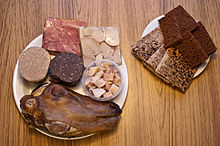Icelandic cuisine
The Icelandic cuisine is the national cuisine Islands .
history
Due to the harsh climate and long winters, Icelandic cuisine was very sparse. She hardly knew any spices and traditionally used everything edible. The main preparation method was cooking .
The basis of Icelandic cuisine was fishing . The livestock in Iceland was limited to sheep , cows and horses . Including seabirds such were therefore eaten razorbills , guillemots , black guillemots , puffins and their eggs , but also Wal and - seal meat . Growing cereals and vegetables was hardly possible in Iceland due to the geographical location, as a result it was hardly used in Icelandic cuisine. Therefore, for centuries, bread did not play an essential role in nutrition. Flour could partly be replaced by ground Icelandic moss . Turnips , cabbage , rhubarb , various types of ampfers , angelica and berries such as blueberries , bogberries and crowberries provided vitamins. Juniper berries , Icelandic thyme ( blóðberg ), chervil and caraway were used as seasoning.
An Icelandic specialty is skyr , a type of cream cheese. The whey obtained from cheese production was used for various drinks and for preserving meat products. The preservation of meat and other foods was very important in order to survive the long winters. The methods used for this were smoking , curing , drying , salting , lactic pickling and fermentation .
Traditional dishes
The majority of traditional dishes are only served on certain festive days and the Þorrablót winter festival . Served with potatoes and Rübenmus eaten as a digestive is Brennivín drunk. Many of these dishes, called Þorramatur , arouse alienation among foreigners, but also modern Icelanders, due to their consistency, smell or taste.
- svið , singed, boiled sheep's heads
- hákarl , fermented shark that would be poisonous and inedible if freshly prepared
- lundabaggar , cooked and pickled sheep innards
- kæst skata , fermented ray, is prepared like the shark and served on December 23rd
- selshreyfar , pickled seal fins
- saltkjöt ( cured meat), is often eaten as a soup
- síld , marinated herring
- slátur , sheep offal cooked in a sheep's stomach , similar to Scottish haggis
- súrsaðir hrútspungar , mutton testicles pickled in whey, sometimes also prepared as a pie
Icelandic cuisine today
Since the 1950s it has in Iceland as well as in Central Europe in the supermarket a wide range of products, which contributes to the diversity of the kitchen. Vegetables, especially tomatoes , are now also grown in geothermally heated greenhouses . Prawns and many types of sea fish are on the table, with haddock being preferred to cod . Edible mushrooms that grow on the island such as bovist , birch mushroom or meadow mushroom are now also eaten.
The Icelandic lambs, who spend a large part of their lives in wild pastures, are slaughtered when they are about six months old. Mutton from older animals is considered to be of inferior quality and is almost only offered processed (for example as cured boiled sausage kindabjúga ). Some of the traditional dishes are still often served today. These include hangikjöt , skyr and stockfish (a popular snack in Iceland with a little butter). Others, such as bjúgu , beets or cured meat ( saltkjöt ) are considered poor people's food and are becoming less important.
Despite international outlaws, Iceland continues to whale. Minke whale meat is available in Iceland. However, it hardly plays a role anymore for the country's cuisine. The main consumers of whale meat in Iceland are now tourists.
The most popular drink among Icelanders is coffee . It is drunk all day until evening ( Kvöldkaffi ). The Molakaffi is a specialty : sugar cubes ( Sykurmolar ) are served with black coffee . You put the sugar in your mouth and drink the coffee through this piece, like in the Orient.
Specialties
The specialties of modern Icelandic cuisine include wild salmon , trout and char , wild fowl such as geese , ducks and sea birds as well as sea fish and lamb . Reindeer is also served in restaurants on special occasions .
Typical Icelandic desserts can be kleinur , a lard, crepe- like pönnukökur , plinsen -like lummur , Laufabrauð , a traditional Christmas cake, and cocoa soup with rusks.
Furthermore, rúgbrauð (rye bread) is known.
See also
literature
- Maike Hanneck: Iceland cookbook. 1st edition. túrí, Hvammstangi 2004, ISBN 9979-9641-0-3 .
- Ursula and Markus Jäger: Leckeres Iceland - The great cook and baking book . 3rd edition, Books on Demand, 2016, ISBN 978-3-8423-7704-2 .
Web links
- Brief overview of Icelandic food (with Icelandic-German glossary), accessed on October 14, 2008
- Article about buffalo rays


